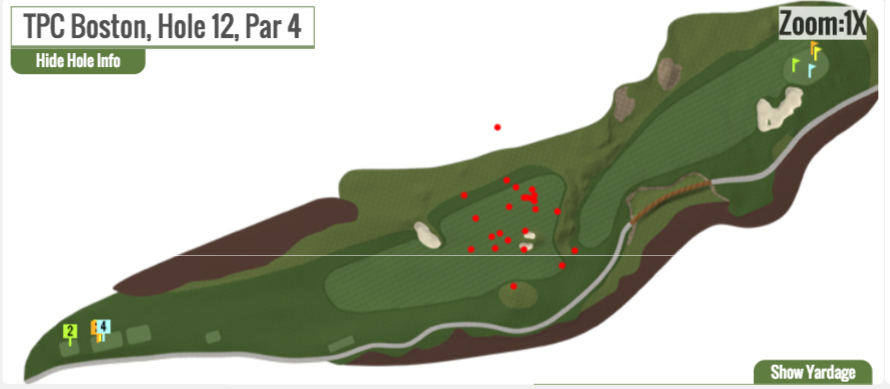The Players vs. Centerline Bunkers: The 12th at TPC Boston
The PGA Tour bows to player complaints


Never forget who runs the Tour… it’s the players.”
– Tom Doak
Last year, TPC Boston debuted a new 12th in the latest of a series of tweaks made by architects Gil Hanse and Jim Wagner of Hanse Golf Design. The 12th featured a centerline bunker, a controversial design feature. One year later, TPC Boston debuts a new 12th hole without a centerline bunker.
A history lesson
Today, TPC Boston has a claim as the most interesting course in the TPC’s portfolio. It’s a remarkable feat considering the course’s reputation as one of the Tour’s most boring and generic courses in the mid-2000’s. TPC Boston is a model for what can be done with the plethora of poorly-conceived courses that plague American golf. Gil Hanse and partner Jim Wagner have infused strategy and aesthetic interest through a redesign and ongoing tweaks to the property since 2006. The final batch of planned changes were made prior to the 2017 championship on the 12th and 13th holes. The back-to-back par 4’s were the only remaining holes from the original Arnold Palmer design. Up until last year, all of Hanse Golf Design’s changes to TPC Boston had been met with universal fanfare.
Arnie’s 12th
Prior to the playing of the 2017 edition of the Dell Technologies Championship, the 12th hole at TPC Boston was your standard out-of-the-box par 4. It measured 456 yards off the tee and the approach shot was to a green protected by wetlands on the right and back half of the green.

The design of the 12th hole at TPC Boston until 2017
It’s the type of golf that most PGA Tour pros have come to expect: a simple test of execution. Like most holes on Tour, off the tee, hitting the ball the farthest and straightest was the objective. The 12th’s angled green would benefit players who hit the left part of the fairway, but its narrow 30-yard fairway (remember this number) deterred any attempt at doing so. Simply put, the 12th was a boring golf hole.
“It was one of the better holes. You don’t need to change it.”
— Justin Thomas
Ch-ch-ch-changes
After a major reworking by Gil Hanse, the one thing that the new 12th couldn’t be described as was boring. It stretched to over 500 yards and had its entire topography reworked. Off the tee, the 12th fairway runs downhill before an angled ridgeline cuts through the fairway with a severe downslope and native grasses. On the left side, the fairway runs out 320 yards from the back tee and at 335 yards from the right tee. Hanse expanded the fairway from 30 to 60+ yards wide and added a few strategic bunkers. The first fairway bunker requires a 250-yard carry from the back tee and sits on the left side of the fairway. The second and more controversial bunker was the centerline principal’s nose, which sat 300 yards from the back tee. The new green is guarded by a front right bunker, which creates a “line of charm” or ideal line up the left side. Thanks to the fairway bunkering, the left was the more difficult portion of the fairway to find. It asked players to not only hit a tee shot straight, but also the proper distance. A shot struck too softly could find the first bunker on the left. One too hard could bound through the fairway into the native grasses on the downslope of the ridge. One just right would yield the shortest approach shot with the best angle. While a challenge, the fairway left of the centerline bunker was a 31-yard area, one yard wider than the old hole.

The 2017 version of the 12th at TPC Boston
For players who were uncomfortable with a shot up the left, Hanse provided a safe option, layup short of the centerline bunker to a section of the fairway over 55 yards. The safer choice came with the drawback of a 220+ yard approach from a worse angle on the right side. The 12th was a hole that curbed distance and accomplished the rare feat of forcing the modern Tour pro to hit mid-to-long iron approach shots.
The 12th was a different test than most par 4’s on Tour. It tested precision rather than power. After one practice round, players voiced their displeasure. Kelly Kraft was the first to strike, Paul Casey called the 12th “awful” and Justin Thomas responded with “hoping I wouldn’t get asked this” before flaming the redesign saying, “I personally don’t think that it was a very good job redesigning it.” Thomas went on to win the event and play the hole up the neighboring 13th fairway all four rounds. A shot he and a few other long players in the field tried, which required a blind shot over trees.
The results
Ultimately, the player complaints led to action from the Tour. During the tournament, they played the hole up a tee box three of the four days. A particularly odd move that made the hole more awkward for players, with the ridge cutting in at 295 yards. The forward tees also made it easier for players to play down the 13th. On Friday, the one day the tees were on the suggested back tee box, Thomas was the only player who successfully attempted the heroic shot, and the 12th played to the lowest scoring average of the week.
Looking at the data, the 12th proved to be a fascinating hole and a strategic one during the week.
- Over the four days, the hole yielded eighteen birdies from the left side of the fairway/rough compared to just five from the right.

- Players who found the left half of the fairway hit the green 40% of the time versus 23% from the right
- Justin Thomas was the only player who made a birdie playing from the 13th fairway.
- Of the 20 attempts to play up the 13th, nine resulted in bogeys or worse.
- The one day (Friday) the Tour played the back tee box, the hole played to the lowest scoring average.
- On Friday, the average driving distance was 289 yards versus the other three-day average of 276 yards.
The fallout
Despite over a decade of flawless work at TPC Boston, the Tour sided with the players and removed Hanse’s centerline bunker from the 12th for the 2018 championship.

The 12th hole at TPC Boston in 2018 without the centerline bunker
With the removal, the strategy behind the 12th is diminished. Surely, more birdies will come from the left, but a tee shot that requires both accuracy and distance control no longer exists. In our podcast with Gil Hanse, he remarked on centerline bunkers:
“They ask a question that most golfers aren’t comfortable answering.”
It turns out, centerline bunkers even make the best players in the world uncomfortable. Their knee jerk reaction was to complain, and the Tour listened to their complaints despite no player ever explaining why it was a bad hole. It’s a shame player discomfort leads to course changes rather than the treat of seeing shotmaking.
Leave a comment or start a discussion
Engage in our content with thousands of other Fried Egg Golf Club Members
Engage in our content with thousands of other Fried Egg Golf Members
Get full access to exclusive benefits from Fried Egg Golf
- Member-only content
- Community discussions forums
- Member-only experiences and early access to events











Leave a comment or start a discussion
Lorem ipsum dolor sit amet, consectetur adipiscing elit. Suspendisse varius enim in eros elementum tristique. Duis cursus, mi quis viverra ornare, eros dolor interdum nulla, ut commodo diam libero vitae erat. Aenean faucibus nibh et justo cursus id rutrum lorem imperdiet. Nunc ut sem vitae risus tristique posuere. uis cursus, mi quis viverra ornare, eros dolor interdum nulla, ut commodo diam libero vitae erat. Aenean faucibus nibh et justo cursus id rutrum lorem imperdiet. Nunc ut sem vitae risus tristique posuere.